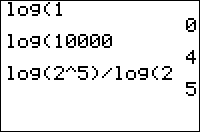TI-BASIC:Log
Command Summary
Computes the (principal branch of the) base 10 logarithm.
Command Syntax
log(value)
Menu Location
Press the LOG key to paste log(.
TI-83/84/+/SE
1 byte
The log( command computes the base 10 logarithm of a value -- the exponent to which 10 must be raised, to get that value. This makes it the inverse of the 10^( command.
log( is a real number for all positive real values. For negative numbers, log( is an imaginary number (so taking log( of a negative number will cause ERR:NONREAL ANS to be thrown in Real mode), and of course it's a complex number for complex values. log( is not defined at 0, even if you're in a complex mode.
Advanced Uses
Using either the Ln( or the log( command, logarithms of any base can be calculated, using the identity: Math \log_b{x} = \frac{\ln{x}}{\ln{b}} = \frac{\log{x}}{\log{b}} /math
So, to take the base B log of a number X, you could use either of the following equivalent ways:
:log(X)/log(B)
:ln(X)/ln(B)
This is the exponent to which B must be raised, to get X.
The base 10 logarithm specifically can be used to calculate the number of digits a whole number has:
:1+int(log(N))
This will return the number of digits N has, if N is a whole number. If N is a decimal, it will ignore the decimal digits of N.
Error Conditions
- ERR:DOMAIN when calculating log(0).
- ERR:NONREAL ANS if taking log( of a negative number in Real mode.
